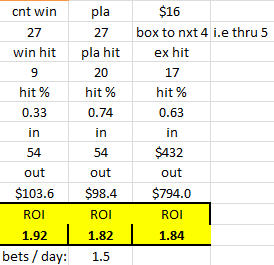Intangibles 2

This post will revisit the idea brought up in the last post (“Intangibles“) – that there are factors in every race that are impossible to predict, and/or difficult to quantify.
Fortunately – there is now a way to get a handle on at least one of these “intangibles.” Some of you won’t have heard of this new tool that is freely available to all handicappers. Many will have heard of it, but won’t have taken the next step and put it to use in order to increase bottom-line profits – while a very few astute handicappers will already be using their own unique approach with this data.
We’ll go over the basics – give you some pointers and valuable links – provide a general base from which you can continue your own research – And: we will also make a very restricted offer to a few of you. Interested?
What does it really mean when you hear someone say, “The horse was wide around the far turn,” or “He raced wide down the backstretch and was 5-wide around the turn for home.” How do we as handicappers quantify this information? How do we use it?
There is an old adage that each ‘position’ a runner is wide around a turn costs him just shy of a length (if +/- 8′ = one length) at the wire. But of course that’s a ‘ballpark’ number, and varies with the tightness and distance of the turns (which varies from racetrack to racetrack) – how far out the rail is that day – whether the inside horse/s are able to “cut-the-corner” – whether the horses that are fanned wide stay wide and run straight down the stretch, or angle back towards the inside horses and the rail – etc. etc.
Further – these judgments are made by the chart callers – and therefore subject to error.
When you do any kind of serious trip-handicapping, and closely watch the replay videos of races – it soon becomes obvious just how far off these guys can be. Many times a call of “3-wide” is entirely misleading because they are often referring to the number of horses to the inside of the ‘called’ horse . . . but if each of those horses was in a path other than the ‘one’ and two’ path – then?
In the last post, I gave the example from the Kentucky Derby. The charts of the race called American Pharoah “5-wide” on both turns, but he was quite a bit wider than that into the stretch, and what about the extra distance caused by starting from way outside and angling in to get the supposed 5-wide position into the first turn?
You can now quantify these intangibles down to the exact distance run – within ‘1 foot’ – by using Trakus.
As many of you will know – Trakus is a company that has contracted with several tracks (Churchill, Belmont, Saratoga, Aqueduct, Woodbine, Santa Anita, Gulfstream, Indiana Downs) to place a ‘chip’ in the saddle cloth of each horse in the race so that a computer can calculate the ‘exact’ distance each horse runs in each race. They make this information free to the public (so far?!) – and this is how the handicapper can now ascertain that, in fact, American Pharoah ran exactly 29 feet farther in the race than did second place finisher Firing Line – and 69 feet farther than third place finisher, Dortmund.
How to use this information?
One way – naturally – is by discounting/adjusting the extra distance run in one race to predict how the horse might run in the next race.
Again – the example I gave in the previous post – this year’s Preakness – is a good example. Since ‘Pharoah figured to go to the lead from the inside post in the Preakness – he would now likely ‘re-coup’ the lost distance of the Derby (“shortest distance between two points” theory), and sure enough – the winning margin in lengths that race was very close to the lengths lost in the Derby.
One of racing’s perplexing questions has always been – can a winner repeat? Horses that have won their last race are nearly always overbet, so we need an added positive factor pointing to them if we are to make a wager . . . i.e. our estimation of their potential to win must justify the often lower odds.
If you have the knowledge that a horse who won by say – one length – in fact had to also run the equivalent of 2 or 3 lengths farther than both the second and third place finishers – this is information the masses don’t have. This runner won’t be bet down as much as he would have been if the pp’s showed a win by 3 or 4 lengths.
Even more so – say a horse runs third and finishes 2 lengths behind the second place finisher who was 1 length behind the winner . . . when in actuality he had to run 6 lengths farther than either of those top two finishers? His odds will be much more generous in his next race (if at similar level, distance, and surface) than they would have been if he’d run the same distance and won the race by a couple of lengths!
You will be able to find lots of interesting scenarios by perusing the Trakus data (like you do the pp’s you already use): there are many races where the winner had to run farther than every other horse in the race (!) – and races where every other horse in the race ran farther than the winner – and races where a long odds horse won, but ran a much shorter distance than the favorite (and what if they are meeting again today?!) – etc.
In my research to date, I’ve found that this data (like any data) cannot be used as “stand-alone.” By itself, it’s not the golden egg – but when some filters are added, it really becomes quite profitable.
I don’t give nearly as much credence to positive Trakus data if the horse subsequently jumps up in class, or switches to a new surface or distance (to the point of usually passing on these types). However, by adding common-sense filters that cover the basic handicapping factors for speed, class, form, etc. and then playing only a subset of Trakus qualifiers, I’ve uncovered some easily accessible profits.
Do some investigation of your own with the links below – play with it – you’ll likely come up with some very enticing situations using information that the masses are not using (unlike every other piece of information readily available in the past performance data).
Below is a starting point process you might consider:
- If you want to read over their main site for background – go here: http://www.trakus.com/
- Go to the Trakus information page on a participating track – for example Gp: http://tnetwork.trakus.com/tnet/t_Gulfstream.aspx
- Choose some date in the past, and start going over the races one-by-one (mainly the “Finish” screen)
- When you find a horse that fulfills the minimum criteria you’ve set – add that horse to your ‘list’
- You’ll need to set up some record-keeping – a spreadsheet, a notebook, whatever
- When one of your qualifiers enters its next race – check to see that it is well-placed and meets your min. criteria
- If minimum acceptable odds are also met (or you could pre-set min. acceptable wager odds and early-bird bet if you have an account with that capability) – you have an advantaged wager.
Trakus track pages:
Indiana Downs: http://indianagrand.com/racing/trakus/
Gulfstream: http://tnetwork.trakus.com/tnet/t_Gulfstream.aspx
Belmont: https://www.nyra.com/belmont/handicapping/belmont-trakus/
Santa Anita: http://www.santaanita.com/horse-racing/interactive/trakus/
Woodbine: http://www.woodbineentertainment.com/Woodbine/Racing/Trakus/Pages/WoodbineThoroughbred.aspx
Churchill: http://www.churchilldowns.com/racing-wagering/handicapping/trakus
Okay?! You’ve got enough to start, and I can promise you the value in starting – and having information not widely used – will lead you to profits you wouldn’t otherwise get.
On the most recent set of 100 horses I added to my list who have come back to race (through 6/10/15) – I got the results shown below . . .
For horses that met the minimum general handicapping filters I had set – there were 53 qualifiers from the 100 listed. At the minimum $2 win and place wager and $2 exacta (8 combinations per race):
.
For a sub-subset, super spot play I discovered – there were 27 qualifiers from the 100 – with following results:
.
As stated – this is your starting point and you’ve got a bit of work to do, but it’s all there for the finding.
Good hunting to all of you!
– Gary / Horse Racing Gold



Please add me to the Trakus method list. Thank you.
Lill – Apologies Lill, but the Trakus Method sign-ups have been cut off now. As we stated from the start – we are restricting the number of players to have this info. Best regards – Gary
Please include me for Trakus
I’m interested Gary.
I am interested in the trackus system.
Gary,I have an interest in the Trakus method.
Good Day Gary – This is quite intriguing, especially the ‘super-spot’ plays for the ‘place’ spot and ‘perfecta’. Please include me on your mailing list using Trackus for your ‘methodology’. Providing, of course, space and/or offer is still available. Get the good oil! Andrew
I interest in Trakus Data system
I would be interested in this information as well!
Interesting view. When available please let me know.
Gary – I like what I see from your description, so I would definitely be interested in the Trakus “method” – Thanks – Joe
I’m also interested in this new method.
All inquiries will be responded to via private email – Gary
I am interested in this offer.
I am intrested in your trakus system
I Am requesting the TRAKUS DATA system when ready. Thankyou.
Yes, I’m interested. That is some new information that I was not privy to. I could use that to augment my angle plays. Thanks for bringing this to my attention.
o.k. please give me more info